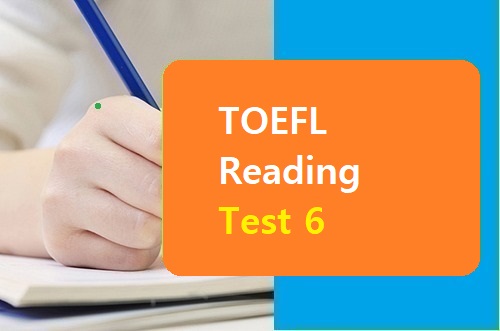TOEFL Reading Test 1
Charles Darwin’s Theory of Evolution
(1) Charles Darwin’s Theory of Evolution is known as one of the most important and controversial scientific theories ever published. Darwin was an English scientist in the 19th century best known for his book “On the Origin of Species.” In his book, Darwin postulated different species shared characteristics of common ancestors, that they branched off from common ancestors as they evolved, and that new traits and characteristics were a result of natural selection. The theory is based on the assumptions that life developed from non-life and progressed and evolved in an indirect manner. Therefore, the Theory of Evolution, while controversial, has shaped and influenced the modern scientific world’s thinking on the development of life itself. Darwin was born February 12, 1809 in England. Although initially entering into medicine, Darwin chose to pursue his interest in natural science and embarked on a five-year journey aboard the H.M.S. Beagle, a British sloop belonging to the Royal Navy. Because of his experience aboard the Beagle, he laid the foundation for his Theory of Evolution while also establishing himself within the scientific community. Specifically, Darwin’s keen observation of the fossils and wildlife he saw during his time on the Beagle served as the basis for the cornerstone of his theory : natural selection.
(2) Natural selection contributes to the basis of Darwin’s Theory of Evolution. One of the core tenets of Darwin’s theory is that more offspring are always produced for a species than can possibly survive. Yet, no two offspring are perfectly alike. As a result, through random mutation and genetic drift, over time offspring develop new traits and characteristics. Over time beneficial traits and characteristics that promote survival will be kept in the gene pool while those that harm survival will be selected against. Therefore, this natural selection ensures that a species gradually improves itself over an extended duration of time. On the other hand, as a species continues to ‘improve’ itself, it branches out to create entirely new species that are no longer capable of reproducing together.
(3) Through natural selection, organisms could branch off of each other and evolve to the point where they no longer belong to the same species. Consequently, simpleorganisms evolve into more complex and different organisms as species break away from one another. Natural selection parallels selective breeding employed by humans on domesticated animals for centuries. Namely, horse breeders will ensure that horses with particular characteristics, such as speed and endurance, are allowed to produce offspring while horses that do not share those above-average traits will not. Therefore, over several generations, the new offspring will already be pre-disposed towards being excellent racing horses.
(4) Darwin’s theory is that ‘selective breeding’ occurs in nature as ‘natural selection’ is the engine behind evolution. Thus, the theory provides an excellent basis for understanding how organisms change over time. Nevertheless, it is just a theory and elusively difficult to prove. One of the major holes in Darwin’s theory revolves around “irreducibly complex systems.” An irreducibly complex system is known as a system where many different parts must all operate together. As a result, in the absence of one, the system as a whole collapses. Consequently, as modern technology improves, science can identify these “irreducibly complex systems” even at microscopic levels. These complex systems, if so inter-reliant, would be resistant to Darwin’s supposition of how evolution occurs. As Darwin himself admitted, “To suppose that the eye with all its inimitable contrivance for adjusting the focus for different distances, for admitting different amounts of light, and for the correction of spherical and chromatic aberration, could have been formed by natural selection, seems, I free confess, absurd in the highest degree”.
(5) In conclusion, “On the Origin of Species” is known as one of the most consequential books ever published. Darwin’s Theory of Evolution remains, to this day, a lightning rod for controversy. The theory can be observed repeatedly, but never proven, and there are a plethora of instances that cast doubt on the processes of natural selection and evolution. Darwin’s conclusions were a result of keen observation and training as a naturalist. Despite the controversy that swirls around his theory, Darwin remains one of the most influential scientists and naturalists ever born due to his Theory of Evolution.
1. According to paragraph 1, where did Charles Darwin begin to observe and formulate the basis for his Theory of Evolution?
(A) Medical School
(B) Observing Horse Breeders
(C) England
(D) Aboard the H.M.S. Beagle
Jawaban : D
2. The word ‘postulated’ in paragraph 1 is closest in meaning to :
(A) disagree
(B) prove
(C) oppose
(D) hypothesize
Jawaban : D
3. Which sentence is most similar to the following sentence from paragraph 1? The theory is based on the assumptions that life developed from non-life and progressed and evolved in an indirect manner.
(A) The Theory of Evolution is founded on evidence that non-organic compounds are the basis of life, developed in an unguided way.
(B) Based on certain assumptions, we can prove that evolution occurs in all living and non-living entities.
(C) According to Darwin, if we assume that life at its origin was created from non-organic compounds and developed in an unguided manner, his theory holds true.
(D) Due to the controversy, it is hard to make assumptions about the Theory of Evolution.
Jawaban : C
4. According to paragraph 2, what are the causes for species developing new traits and characteristics?
(A) medicine and longevity
(B) survival and selection
(C) mutation and genetic drift
(D) tenets and theory
Jawaban : C
5. The word ‘those’ in paragraph 2 refers to :
(A) gene pool
(B) survival
(C) natural selection
(D) traits and characteristics
Jawaban : D
6. According to paragraph 3, what is natural selection most comparable to as a process?
(A) branching trees
(B) selective breeding
(C) irreducibly complex systems
(D) the human eye
Jawaban : B
7. What is the purpose of paragraph 3 in the passage?
(A) To show the simple-to-complex nature of natural selection in context
(B) To create doubt as to the validity of the theory
(C) To contrast with the ideas presented in paragraph 2
(D) To segue into the main point presented in paragraph 4
Jawaban : A
8. The word ‘contrivance’ in paragraph 4 is closest in meaning to :
(A) organization
(B) retention
(C) absurdity
(D) systems
Jawaban : D
9. The word ‘consequential’ in paragraph 5 is closest in meaning to :
(A) important
(B) measurable
(C) fragmented
(D) dismissible
Jawaban : A
10. All of the following are mentioned in paragraph 4 as a viewpoint to state that natural selection is difficult to prove EXCEPT
(A) The belief that the complexity of the human eye could have been formed by natural selection seems highly unlikely
(B) The presence of irreducibly complex system contradicts how evolution occurs
(C) Modern technology has been used to prove that irreducibly complex systems exists
(D) Selective breeding is the major hole in the theory of natural selection
Jawaban : D
Info Belajar Bahasa Inggris Online DI SINI
Ingin Kursus Bahasa Inggris? Ikuti kelas online English Fast sekarang !!!!
Kelas Online Terbaik, Ya di English Fast !!!!







10 Comments
Halo kak, kalau mau ikut kelas yang TOEFL GRATIS masih bisa ?
bisa ya kak, bisa isi form di link : https://englishfast.net/live/ …
Sangat bermanfaat min..
Terimakasih,…
Sangat membantu tesnya..
Terimakasih…
Super lengkap websitenya..
Terimakasih ….
SANGAT BERMANFAAT
Terimakasih…